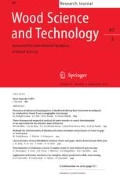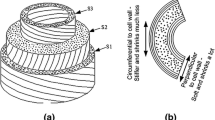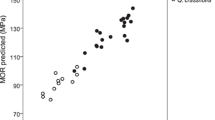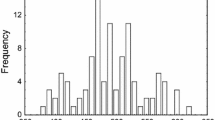Summary
Shrinkage observed on small clear specimens in radial and tangential directions and volumetric shrinkage obtained under the evaluation of physical and mechanical properties of wood have been analysed with reference to specific gravity and fibre-saturation point (FSP). It is observed that tangential shrinkage is 1.4 to 3 times that of radial shrinkage. The difference between FSP in radial and tangential direction is not so predominant; it is possibly governed by variation in specific gravity of the wood substance. The volumetric shrinkage is noted to be approximately equal to the sum of radial and tangential shrinkages. Shrinkage is found to depend on both the specific gravity of wood and FSP. Unlike Stamm's theory, their effect is found to be additive. The effect of specific gravity is found to be more than the effect of FSP.
Zusammenfassung
Die Radial- und Tangentialschwindung kleiner fehlerfreier Proben sowie die Volumenschwindung, die während der Bestimmung der physikalischen und mechanischen Eigenschaften der betreffenden Hölzer beobachtet werden konnten, wurden hinsichtlich ihres Zusammenhanges mit Dichte und Fasersättigungspunkt untersucht. Die Beobachtungen zeigten gegenüber der Radialschwindung eine 1,4... 3,0-fach größere Tangentialschwindung. Der Unterschied bei Erreichen des Fasersättigungspunktes in radialer und tangentialer Richtung ist nicht so auffällig; möglicherweise wird er überwiegend von der Dichte der Holzsubstanz bestimmt. Es konnte weiterhin festgestellt werden, daß die Volumenschwindung etwa gleich der Summe aus Tangential- und Radialschwindung ist und sowohl von der Dichte der Holzart als auch vom Fasersättigungspunkt abhängt. Entgegen der Theorie von A. J. Stamm wurde deren Wechselwirkung als additiv erkannt, wobei der Anteil der Dichte etwas größer als derjenige des Fasersättigungspunktes sein dürfte.
Similar content being viewed by others
References
Brown, H. P., A. J. Panshin and C. C. Forsaith: Text Book of Wood Technology, Vol. II, p. 37/38. London, 1949: McGraw-Hill.
Greenhill, W. L.: The Shrinkage of Australian Timbers, Part II, C.S.I.R.O. Pamphlet No. 97. Melbourne 1940: C.S.I.R.O.
Indian Standards Institution: Methods of Testing Small Clear Specimen, Part I, IS: 1708 — 1960. New Delhi: Indian Standards Institution.
Kelsey, K. E.: The Shrinkage Intersection Point, its Significance and the Method of its Determination. For. Prod. J. Vol. VI (1956) No. 10 p. 411/417.
Krpan, J.: Untersuchungen über den Fasersättigungspunkt des Buchen-, Eichen- und Tannen- und Fichtenholzes. Holz als Roh- und Werkstoff Vol. 12 (1954) p. 84/91.
Newlin, J. A., and T. R. C. Wilson: The Relationship of the Shrinkage and Strength Properties of Wood to its Specific Gravity. U.S. Dept. Agrie. Bull. No. 676, 1919.
Seaman, L. N.: The Practical Values of Laboratory Shrinkage Determination. Indian Forester Vol. 59 (1933) p.341/345.
Stamm, A. J.: Colloid Chemistry of Cellulosic Materials. U.S. Dept. Agric. Misc. Publication No. 240, 1936.
Wangaard, F. F.: Tests and Properties of Tropical Woods. For. Prod. Res. Soc. Proc. Vol. 5 (1951) p.206/214.
Wise, L. E., and E. C. Jahn: Wood Chemistry, Vol. 2, Ed. II p. 723/732. New York 1952: Reinhold Publishing Corp.
Author information
Authors and Affiliations
Rights and permissions
About this article
Cite this article
Sekhar, A.C., Rajput, S.S. Some studies on the shrinkage behaviour of wood. Wood Science and Technology 1, 99–108 (1967). https://doi.org/10.1007/BF00353382
Received:
Issue Date:
DOI: https://doi.org/10.1007/BF00353382




